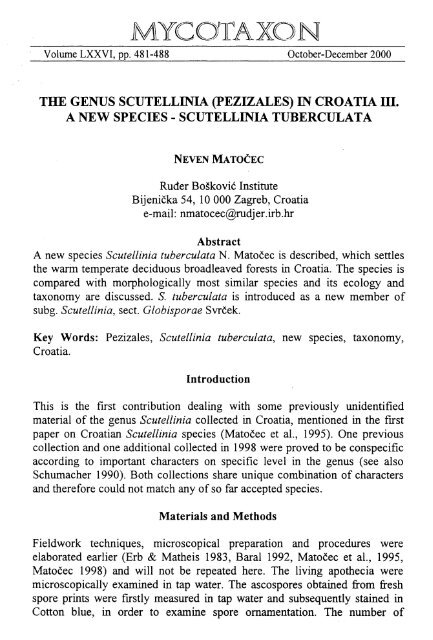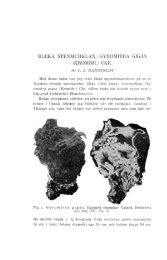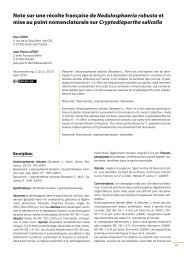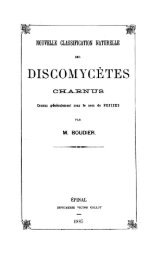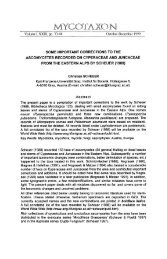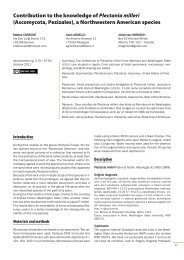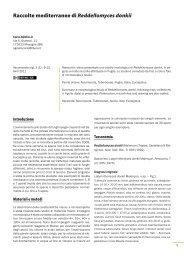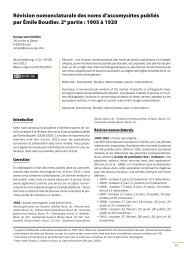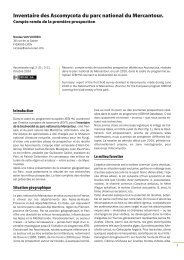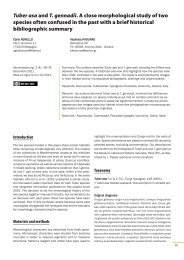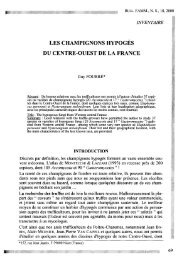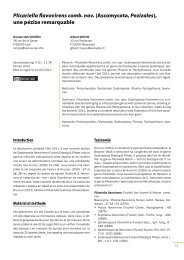THE GENUS SCUTELLINIA (pEZIZALES) IN ... - Ascomycete.org
THE GENUS SCUTELLINIA (pEZIZALES) IN ... - Ascomycete.org
THE GENUS SCUTELLINIA (pEZIZALES) IN ... - Ascomycete.org
Create successful ePaper yourself
Turn your PDF publications into a flip-book with our unique Google optimized e-Paper software.
Volume LXXVI, pp. 481-488 October-December 2000<br />
<strong>THE</strong> <strong>GENUS</strong> <strong>SCUTELL<strong>IN</strong>IA</strong> (<strong>pEZIZALES</strong>) <strong>IN</strong> CROATIA ill.<br />
A NEW SPECIES - <strong>SCUTELL<strong>IN</strong>IA</strong> TUBERCULATA<br />
NEVEN MATOCEC<br />
Ruder Boskovic Institute<br />
Bijenicka 54, 10 000 Zagreb, Croatia<br />
e-mail: nmatocec@rudjer.irb.hr<br />
Abstract<br />
A new species Scutellinia tuberculata N. Matocec is described, which settles<br />
the warin temperate deciduous broadleaved forests in Croatia. The species is<br />
compared with morphologically most similar species and its ecology and<br />
taxonomy are discussed. S. tuberculata is introduced as a new member of<br />
subg. Scutellinia, sect. Globisporae Svrcek.<br />
Key Words: Pezizales, Scutellinia tuberculata, new specIes, taxonomy,<br />
Croatia.<br />
Introduction<br />
This is the first contribution dealing with some previously unidentified<br />
material of the genus Scutellinia collected in Croatia, mentioned in the frrst<br />
paper on Croatian Scutellinia species (Matocec et aI., 1995). One previous<br />
collection and one additional collected in 1998 were proved to be conspecific<br />
according to important characters on specific level in the genus (see also<br />
Schumacher 1990). Both collections share unique combination of characters<br />
and therefore could not match any ofso far accepted species.<br />
Materials and Methods<br />
Fieldwork techniques, microscopical preparation and procedures were<br />
elaborated earlier (Erb & Matheis 1983, Baral 1992, Matocec et aI., 1995,<br />
Matocec 1998) and will not be repeated here. The living apothecia were<br />
microscopically examined in tap water. The ascospores obtained from fresh<br />
spore prints were frrstly measured in tap water and subsequently stained in<br />
Cotton blue, in order to examine spore ornamentation. The number of
482<br />
measurements of the ascospores was 50 per collection, 25 for both marginal<br />
and excipular hairs and 20 for both paraphyses and asci. All characters were<br />
examined in both collections. In the species concept, <strong>org</strong>anism delimitation,<br />
fructification definition, and anatomical terminology I was following our fIrst<br />
paper (Matocec et aI., 1995). Ecological observations was made relying on<br />
Bertovic & Lovric (1992).<br />
Abbreviations<br />
NM = private fungarium N. Matocec, Gajnice 13, 10000 Zagreb, Croatia, ZA<br />
= Herbarium of Department of Botany, Faculty of science, University of<br />
Zagreb, Marulicev trg 20/2; CB = cotton blue, CB+ = cyanophillic structures;<br />
CB- = non-cyanophillic structures; glob. = globose; tub. = tuberculate; (*) =<br />
living state ofcell; (tU') = dead state.<br />
Scutellinia tubercuLata N. Matocec, sp. novo<br />
Apothecia exigua, 1.0-1.6 mm. lata, sessilia, cupulata, hymenio explanato,<br />
roseo vel aurantiaco; margine extus setis erectis brunneis vestita. Apothecio<br />
pili superiores 275-795 f-Lm longi, 25.0-46.5 f-Lm lali, acuti, 3-11 septis divisi,<br />
tunica ferruginea, 2.8-5.5 f-Lm crassa, basi bi- vel multi-furcati. Pili inferiores<br />
92-285 f-Lm longi, 13.5-26.0 f-Lm lati, acuti, 1-5 septis divisi, tunica lutea vel<br />
luteo-ochracea, 0.8-3.4 f-Lm crassa, basi simplices vel bifurcati. Excipulum<br />
externum 85-100 f-Lm crassum, e cellulis 22.5-69.5 f-Lm magnis, globularibus<br />
vel angulatis compositum. Excipulum medullare 105-125 f-Lm crassum, e<br />
cellulis minoribus diametro 5.2-15.0 f-Lm compositum. Subhymenium<br />
indistinctum. Asci in statu vivo 245-305 x 24.6-37.0 f-Lm, octospori,<br />
operculati, apice obtuso vel obtuso-truncato. Paraphysae in statu vivo basi<br />
2.4-3.6 f-Lm crassae, rectae, apice clavato-dilatatae, diametro 6.9-16.6 f-Lm.<br />
Ascosporae in statu vivo diametro 18.1-23.4 (23.8) f-Lm, perfecte globosae,<br />
guttulis magnis oleiferis instructae. Tunica verrucosa, verrucae magnae,<br />
tuberculatae, in statu emortuo 1.4-5.8 (7.0) pm latae, 1.4-4.3 pm altae.<br />
Habitat: ad terram nudam humidam in sylva decidua<br />
Holotypus: die 8 Mai annoi 1994 prope rivulum Okicnica in Croatia<br />
centrali, sub numero NM/2235 ab auctore lectus, Universitatis studiorum<br />
Zagrabiensis - ZA depositus; isotypi in Fungario Neven Matocec - NM<br />
depositi.<br />
Scutellinia tubercuLata N. Matocec, sp. novo<br />
Illustrations: Figs. 1-4.<br />
Apothecia small, sessile, cupulate to shallowly cupulate but with plane<br />
hymenial surface, sessile, 1.0-1.6 mm in diam., perfectly circular from the
484<br />
Fig. 1. Scutellinia tuberculata - marginal part of an apothecium with its<br />
marginal hairs (NM/4129), observed in tap water at statu vivo: a - vertical<br />
median section ofthe apothecium; b-d - marginal hair bases (bar=40Jlm).
a<br />
Fig. 2<br />
_b<br />
Fig. 3<br />
Fig.4<br />
485<br />
Figs. 2-4. Scutellinia tuberculata - important taxonomic characters. Fig. 2 <br />
hymenial elements and apothecial hairs (NM/2235, type) obtained from thin<br />
hand-section without squashing and observed in tap water at statu vivo: a <br />
mature ascus (bar=lOOflm); b - paraphyses (bar=20flm); c - excipular hairs<br />
and d - marginal hairs (bar=1OOflm). Figs. 3, 4 - ascospores from the fresh<br />
spore-print, stained in CB, observed under oil-immersion (bar=20flm). Fig. 3<br />
- collection no. NM/2235, type. Fig. 4 - collection no. NM/4129.
486<br />
Collections examined:<br />
NM/2235 Okicnica brook in Samoborsko gorje Mts., Zumberak region, Central<br />
Croatia; UTM 33T WL 56; 8. May 1994.; leg. N, Matocec (holotype in ZA, isotype in<br />
NM); NM/4129 Motovunska suma forest near Motovun, Istria region; UTM 33T VL<br />
12; 20. Nov. 1998.; leg. N. Matocec.<br />
Discussion<br />
Both collections of the species share several unique characters and could not<br />
be conspecific with any of known species, according to all important<br />
characters on specific level in genus Scutellinia, viz. ascospore shape and<br />
dimensions, ascospore ornamentation type and dimensions, marginal hair<br />
dimensions, marginal hair base construction and differentiation degree<br />
among marginal and excipular hairs (cf. Kullman, 1982 and Schumacher,<br />
1990). Mentioned characters in both collections of S. tuberculata are<br />
presented in the following table.<br />
Coli. Marginal hairs Ascospores Ascospore<br />
no. ornamentation<br />
base con- length diam. shape shape diam. shape diam. height<br />
structiofl /Jlm /Jlm<br />
'i1' /Jlm /JlIll /Jlm<br />
*<br />
NM/ bi- to tetra- 282- 25.0-39.7 glob. glob. 18.1-2I.l tub. 1.4-6.4 1.4-4.3<br />
2235 furcate 620<br />
NMI bi- to penta- 275- 27.6-46.5 glob. glob. 19.4-23.8 tub. 3.8-5.8 1.4-3.7<br />
4129 furcate 795<br />
The apothecia from both collections are very small for the genus, e.g. 1,0-1,6<br />
mm in diam. (NM/2235) and 1,4 mm in diam (NM/4129, single apothecium)<br />
and additionally, their hymenia are always pinkish to orange, never red. The<br />
hair differentiation is obvious in both collections, where marginal hairs are<br />
generally much longer than the excipular ones. However, the presence of<br />
hairs with multifurcate bases could easily be overlooked, due to their low<br />
density in each apothecium. It seems that this species could be distributed in<br />
warm temperate region, viz. submediterranean and continental mediterranoid<br />
areas (cf. Bertovic & Lovric 1992).<br />
The species is not likely to be confused with other globose-spored Scutellinia<br />
species because of its unique combination of characters. The small and<br />
orange to pinkish apothecia, occurrence of multifurcate marginal hairs,<br />
medium sized perfectly globose ascospores, beset with very large<br />
hemisphere-shaped tubercles clearly distinguish the species. S. trechispora<br />
(Berk. & Broome) Lambotte has globose spores and multifurcate marginal<br />
hairs (500-2000 Jlm in length), but spores measure only 14-18 Jlm and bear<br />
unique bluntly conical to molariform ornamentation. The species is quite<br />
common in Croatia and Slovenia. S. paludicola (Boud.) Le Gal has the same
487<br />
spore ornamentation type with similar dimensions, but spores are much<br />
larger, 25-30 Jlm in diam., and the hairs, which have no differentiation<br />
between marginal and excipular ones are very short, 100-350 J.1m in length<br />
with simple or only exceptionally bifurcate base (Schumacher, 1990). This<br />
species is not recorded in Croatia so far. S. barlae (Boud.) Maire - a species<br />
that is also found in similar habitat in Croatia (Matocec, 1998) has nearly the<br />
same dimensions and the same shape ofthe ascospores. On the other hand, S.<br />
barlae has the same type and dimensions of the apothecial hairs as S.<br />
paludicola and it also differs from S. tuberculata in type and in dimensions of<br />
the spore ornamentation. S. minor (Velen.) Svrcek and S. tuberculata have<br />
overlapping dimensions ofthe marginal hairs and the ascospores. Though, S.<br />
minor has unbranched to trifurcate hair-base· and the ascospores are globose<br />
to subglobose, even in the living state (Matocec, 1998). Additionally, S.<br />
minor has different spore ornamentation type, e.g. roller-shaped to cylindricobtuse,<br />
measuring 1.2-2.1 Jlm in diam. and 0.8-2.2 Jlm in height. Besides, the<br />
species has much larger apothecia (3-8 mm in diam.) and belongs to boreopolar<br />
species group (Schumacher, 1990, 1993). It has only been recorded in<br />
subalpine zone in Croatia (Matocec et aI., 1995).<br />
On account of certain taxonomic characters, S. tuberculata can be placed in<br />
subg. Scutellinia (multifurcate, prominent marginal hairs structurally<br />
differentiated from excipular hairs), section Globisporae Svrcek (ascospores<br />
globose, with prominent, isolated spore ornamentation) as a second member<br />
in the section, nearby S. trechispora (Berk. & Broome) Lambotte.<br />
Acknowledgements<br />
I wish to thank the stuff of Croatian State Directorate for the Protection of<br />
Nature & Environment, which supported the fieldwork in Istria, where I have<br />
discovered the second collection ofthe species. The author is also indebted to<br />
Dr. Ain Raitviir (Tartu) for critically reading the manuscript, and to Dr. A. Z.<br />
Lovric for checking the latin diagnosis.<br />
Literature cited<br />
BARAL, H. 0., 1992: Vital versus herbarium taxonomy: Morphological differences<br />
between living and dead cells of ascomycetes, and their taxonomic<br />
implications. Mycotaxon 44(2): 333-390.<br />
BERTOVIC, S. & A. Z. LOVRIC, 1992: Ubersicht der Vegetation Kroatiens nach<br />
neueren Untersuchungen. TUxenia 12: 29-48.<br />
ERB & MA<strong>THE</strong>IS, 1983: Pilzmikroskopie. Kosmos, Stuttgart.<br />
KULLMAN, B., 1982: A revision of the genus Scute/linia in the Soviet Union.<br />
Scripta Mycologica. Tartu 10: 1-158.
488<br />
MATOCEC, N., O. ANTONIC & D. MRVOS, 1995: The genus Scutellinia<br />
(Pezizales, Ascomycotina) in Croatia: Preliminary part. Natura Croatica 4( 1):<br />
1-58.<br />
MATOCEC, N., 1998: The genus Scutellinia (Pezizales, Ascomycotina) in Croatia,<br />
n.: Scutellinia barlae and S. minor. Natura Croatica 7(2): 91-105.<br />
SCHUMACHER, T., 1990: The genus Scutellinia. Opera Botanica 101: 1-107.<br />
SCHUMACHER, T., 1993: Ecology and Distribution of the Genus Scutellinia in<br />
Norway. - Arctic and alpine Mycology 3. Bibl. Mycol. 150: 215-233.


